Subsea Well Intervention Systems
New ideas compete to become the subsea well intervention standard
Subsea service systems come in many shapes and capacities as the industry chases at-risk deepwater reserves.
Victor Schmidt, Drilling Engineering Editor
Ever since the first wells were drilled the industry has needed to service them. As exploration techniques and tools allowed the industry to move into open water, the well service platform expanded its reach from the plank swamp roads and grew jackup legs to rise above sea level. Eventually, semisubmersible and ship hulls permitted drilling and tending wells off the continental shelf. The steady march into deeper water and the need to extract all possible reserves has now opened the economic window for a new service option, the dedicated subsea well intervention vessel.
The reason for this new specialized vessel class is apparent – cost. Dayrates for full-service drilling platforms, semis or drillships, are very high. To service a subsea well using a deepwater drilling rig is often prohibitively expensive, unless the field is very large and retains enough reserves around the well to make intervention economic. In some cases, the economic equation favors redrilling, but too often the well must be abandoned, leaving significant volumes of oil in the ground.
Well service cost also drives the engineering practices of wellhead and downhole equipment makers. Since deepsea wells are less likely to be serviced, the equipment has to be capable of operating for years with minimal attention. This pushes the cost/ performance envelope to the outer economic limits by engineering for long-service wear and reliability. With an economically viable service option, the engineering specifications needed for today’s subsea equipment can be relaxed and upfront capital expenses reduced.
SERVICE TYPES
Servicing offshore wells is accomplished in three main ways: wireline intervention, coiled-tubing conveyed tools and traditional drillpipe-conveyed tools using a full-service drilling rig. These may be accomplished from a platform, rig or vessel. No one has yet accomplished seabed-based intervention, although it could eliminate many subsea well servicing problems. Such systems are under development.
The industry has chased petroleum prospects in many different water depths and well depths. The multiple operating envelopes for these wells set limits for service configurations needed to tend different subsea wells groups. In addition, metaocean conditions, vessel heave, in-hole casing and equipment, and downhole service problems further complicate the service vessel configurations that must be considered.
Drillpipe has the advantage of being able to perform any well service and is the standard hard connection between the surface rig and the well’s downhole equipment. With drillpipe, service personnel can pull casing, wellheads or other equipment that require significant lifting capacity due to equipment weight or well depth. The addition of a riser allows full fluid communication with the well for recompletion, fracing, treatment and cleanout tasks.
If an intervention fails, the operator also has the option of drilling a replacement well. This is the most expensive option.
Listed below are existing and developing intervention systems to address the servicing needs of subsea wells. Most are using or developing wireline intervention systems, but coiled tubing and seabed drilling packages are under development.
Wireline. Most well interventions can be done with wireline-conveyed tools. The advantages of this proven technology are modest equipment weight, operational flexibility and quick intervention. The disadvantages are in the range of tasks possible. Since the reels and break-weights of the wireline are small compared to coiled tubing or drillpipe, this approach is only for lighter well interventions.
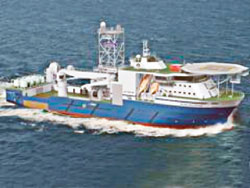 |
Fig. 1. The new subsea well intervention vessel, Island Frontier, began RLWI services in the North Sea.
|
|
RLWI. Riserless Light Well Intervention is an alliance of FMC Technologies, Island Offshore, and Maritime Well Services. These companies have built and equipped a new vessel, Island Frontier, to provide subsea well intervention services, Fig. 1. The new-build monohull is based on the Rolls-Royce UT737L design and began its service April 2005, providing well intervention services for Chevron in Strathspey field, North Sea. It is currently the only subsea intervention system from a dedicated ship-shape vessel.
The dynamically-positioned vessel is operated by Island Offshore Management. It is equipped with a 70-t module handling tower, 130-t deck-mounted crane, ROV and video unit for operation in 500-m water depths with up to 5-m waves. The newbuild carries a lubricator package from FMC Technologies that is lowered through the vessel’s moonpool and positioned over the wellhead, Fig. 2. Wireline services are conducted through the lubricator by Aker Kværner’s Maritime Well Service AS. Its standard tasks include production logging, reperforations and downhole equipment replacement. The vessel can workover live wells and can carry 74 people.
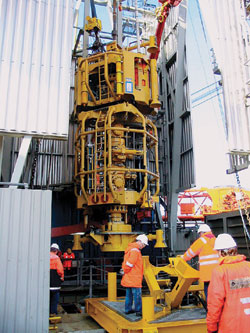 |
Fig. 2. The RWLI’s lower stack is ready to be run through the moonpool.
|
|
Island Offshore Management recently won a NOK 1.5 billion (US$ 230 million) light well intervention contract beginning April 2006. The alliance will provide at least 150 days of service each year through 2012.
 |
Fig. 3. This SWATH/ tri-hull design provides a large deck capacity for simultaneous, multiple well interventions.
|
|
SWATH. Because mono-hull vessels have limited operating capabilities and cannot handle the largest equipment, Quinetiq, in partnership with Offshore Technology Group, have developed a small waterplane area tri-hull design (SWATH) for a subsea well intervention vessel, Fig. 3.
Its three hulls are similar to those used on semisubmersibles and will provide buoyancy to support a large deckload capacity. The design has space for up to five moonpools to handle simultaneous, multiple interventions or complex operations with many in-water tools. The large deckload capacity will provide operational flexibility and either wireline- or coiled-tubing conveyed intervention.
RMSWI. Saipem America Inc. is also using wireline well intervention, featuring its Riserless Modular Subsea Well Intervention system (RMSWI). The equipment includes a subsea BOP, lubricator and running tool controlled by an umbilical from a surface vessel, Fig. 4.
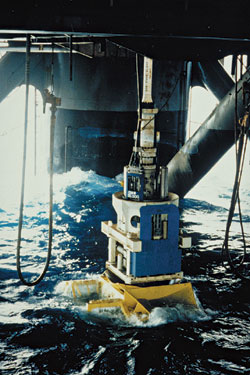 |
Fig. 4. The RMSWI system includes a subsea blowout preventer, lubricator (shown) and running tool controlled by an umbilical from a surface vessel.
|
|
The system is installed on the wellhead from the vessel using an ROV to guide the operation. Once the BOP and lubricator assembly are connected to the wellhead, the ROV connects the umbilical to the system. The system can operate on wells down to 7,000 ft water depth.
A tapered stress joint carries bending loads above the lubricator unit to protect the system, Fig. 5. Wireline intervention is accomplished through the 10,000 psi BOP, which has one ram set for annulus control and dual rams to seal the production casing.
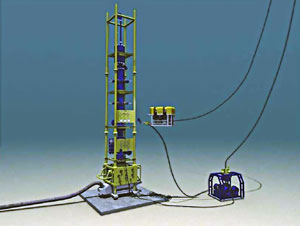 |
Fig. 5. A tapered stress joint carries bending loads above the RMSWI’s lubricator unit.
|
|
The ability of an intervention vessel to leave a location quickly is usually hampered by the need to shut-in the well and remove servicing equipment from the wellhead. Its equipment is directly connected to the wellhead through the vessel’s winches and wirelines.
The RMSWI system operates differently. Once in place, the BOP and lubricator are free-standing on the wellhead with no direct connection to the surface except through the control umbilical. The umbilical is hydraulically connected and disconnected at the wellhead by the ROV. This design allows the vessel to hydraulically “unplug” from the subsea equipment, leaving the intervention equipment on the wellhead and trailing only the control umbilical, which it will then reel in. Thus, in an emergency, the surface vessel can quickly move off location. If the umbilical fails to disconnect, the ROV can actuated a manual release.
Coiled tubing. This is a proven technology using a hard connection. However, it is problematic for ship-shape vessels, because of the weight of the coil, the deck space needed for the large reel and the center-of-gravity shift it imposes upon the vessel. This option works for shallow subsea wells in moderately deep water, using a converted semisubmersible as a working platform that has the space for a removable coiled tubing unit attached to the deck.
MOST. This company is another alliance preparing to bring a new subsea well intervention technology to the market. The M.O.S.T. Inc. consortium’s present ownership includes Eboroil 30%, IPEX 30%, Weatherford 30% and Odin Energi 10%.
The vessel will be dubbed a Multi-Operational Service Tanker (MOST), Fig. 6, and will work in water depths up to 1,200 m. It is planned as a 250 m by 45 m vessel (Suezmax-size shuttle tanker) with DP3 capability. The goal is to create a vessel that can use coiled tubing for light well intervention and other tasks. Harland and Wolff, National, Oceaneering and Weatherford are providing input and equipment to bring the concept to market. Barber Marine Consultants, Enovate, and OEC are also taking part.
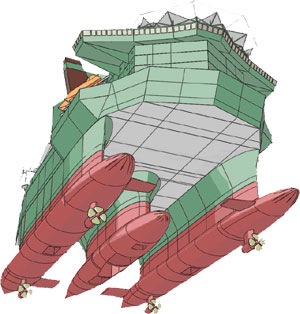 |
Fig. 6. M.O.S.T. Inc. has chosen the MST Odin for conversion into the first multi-operational service tanker.
|
|
The vessel’s main tasks will include subsea installation, well stimulation, injection testing, extended well testing, light interventions, running/ pulling operations, tree replacement, installation/ retrieval of subsea equipment, and decommissioning. It will also be capable of subsea maintenance, well stimulation, well abandonment, and waste disposal. Tankerage is also being considered.
Tasks the vessel will not perform include conventional drillpipe drilling, diving services, running or pulling casing, running marine riser or BOP, snubbing, running or pulling horizontal trees.
Harland and Wolff arranged the construction contract, prepared specifications and did the engineering details. National built the necessary drilling support structures including the moonpool, mechanical and pipe handling equipment, tower, heave compensation system, power and pumps. Oceaneering built the subsea control systems and remotely operated vehicles to support in-water operations.
Weatherford built the intervention unit, process plant, and prepared system specifications for underbalanced drilling. Barber Marine Consultants managed the project, as well as coordinate with the shipyard and consultants. Enovate built the subsea intervention package and OEC handled the safety case.
The vessel will intervene and control XT wellhead systems, have storage for chemicals and mud, include cranes and have sufficient deck space for pulling subsea equipment and making-up equipment on deck. The processing system is designed for 30,000 bbl of liquid per day and up to 60 MMcfpd. A four-reel coiled tubing unit and wireline unit will work from an onboard workover rig. Cyclonic separators will keep the working fluids clean and remove 10 – 400 micron size particles for underbalanced drilling.
M.O.S.T., Inc. hopes to put the first vessel to work in the North Sea, but has plans for other regions including the Gulf of Mexico, Brazil and West Africa. The vessel is preparing to enter the market during 4Q 2005.
Seabed. The Holy Grail for subsea well intervention is to take a full drilling and intervention system to the seabed, because it eliminates many problems. This is a technology still on the drawing board, but the industry is actively pursuing the challenge. Such a system would be highly automated and controlled from the surface by an umbilical and mud-return line.
ASLWI. An autonomous subsea light weight intervention system (ASLWI) is being developed by BP, Shell, Chevron and Expro Group. The ASLWI concept includes a vessel at the surface, which lowers a tool tower and control package to the seabed.
The tower is attached to the wellhead by a ROV and a power unit supplies hydraulic pressure and electricity to the tower and in-hole tools. The unit is connected to the surface by an umbilical, through which service personnel control the action of the seabed tools, Fig. 7.
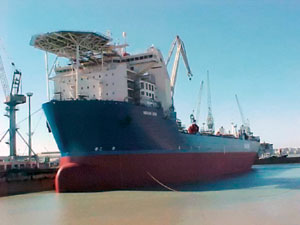 |
Fig. 7. The ASLWI system is projected to cost only one-third of a conventional well intervention.
|
|
The concept has entered Phase 2 this year. Detailed design work is underway, working toward Phase 3, where prototype tools will be built. Field trials are tentatively scheduled for 2007.
SIM. ExxonMobil Corp. has developed a subsea intervention module (SIM) system. SIM uses a 372-ft, dynamically-positioned, vessel supporting a coiled-tubing intervention tool and BOP that attach to the subsea wellhead, Fig 8 and 9. The system is designed to be functional down to 6,500-ft water depth and will be able to workover conventional XT subsea trees with 36-inch structural casings at depths to 13,000 ft below the mudline. This is a larger casing diameter than exists on most subsea wells and is based on Exxon’s future offshore plans.
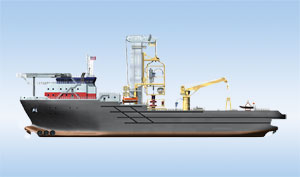 |
Fig. 8. SIM uses a 380-ft, dynamically-positioned, vessel supporting a coiled-tubing intervention tool and BOP functional to 6,500 ft.
|
|
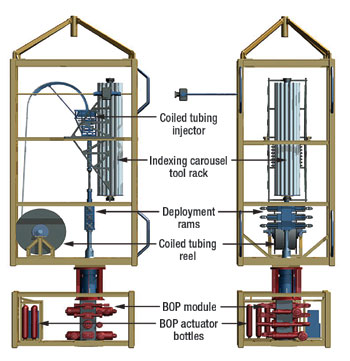 |
Fig. 9. The upper SIM unit holds the reel of 2-in. diameter coiled tubing and a vertical 24-chambered tool carrier.
|
|
The SIM vessel will be a monohull ship about 1.5 times the size of most offshore stimulation vessels. It will feature a large, central moonpool, 36 ft by 43 ft, for tool deployment, a control center for the SIM, ROV and CT teams and accommodations for over 100 people. The vessel with have all the systems needed for subsea intervention work and will be able to stay offshore for a month at a time. This staying power allows for extended work in a given field or for several jobs across a wider area.
The two-piece subsea unit will be lowered to the wellhead using a Huisman deployment system. The lower unit holds the 10,000 psi BOP with pipe rams and dual shears for pressure control.
The upper unit holds the reel of 2-in. diameter CT and a vertical 24-chambered tool carrier, which uses a special injector head for tool changing. The reeled CT carries a wireline inside for logging operations. Fluids for well treatment can be delivered to the wellhead from the vessel by a pipe-in-pipe CT, 1-in.inside 2-3/8-in. This allows chemical treatments to be separated and staged through either flowpath. Once the treatment is completed, the well is unloaded back to the production facility. Fluids never return to the SIM vessel.
The tool carrier is reminiscent of a Gatlin gun turned vertical. Its 24 chambers are designed to hold 18 work tools with backups. Two of the chambers can receive tools conveyed from the vessel if replacements are needed.
ExxonMobil expects the system to perform downhole logging, acidizing and other tasks at one-half the cost of using semisubmersible-based intervention and at only one-third the normal intervention time. Joint venture partners BJ Services Co. and Otto Candies, LLC have licensed the system to build and deploy it by 2008. Its first job will likely be offshore West Africa.
Maris International. Another drawing board concept is the modular, automated, seabed drilling rig, see World Oil, Dec 2004, p. R-26. This idea might be modified to perform well intervention, assuming that the rig could be converted to sit atop a subsea tree, and that its continuous circulation system – now in land service – could enhance its snubbing capabilities, allowing live well entry, Fig. 10.
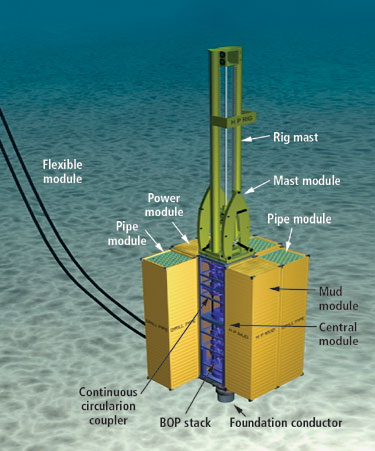 |
Fig. 10. Up to 10 modules, including BOP stack, mast and conductor-pipe mounting plate are assembled by an ROV.
|
|
The concepts’ ten modules would be assembled on the seabed with the help of specialized ROVs. The automated rig would be controlled through an umbilical and require a mud-return line for drilling operations.
CONCLUSION
Subsea wells, especially deepwater, because of the large in-place reserves and drilling economics, limit the number of wells drilled to access each field.
These high-spec wells will eventually yield to wear, corrosion and age. This makes intervention necessary to extract the maximum reserves from each field and to prepare the fields for future secondary and tertiary production. The industry is already intervening from one ship-shape vessel, but it can expect more options in the next few years. 
|












